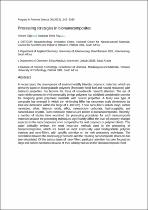JavaScript is disabled for your browser. Some features of this site may not work without it.
- ResearchSpace
- →
- Research Publications/Outputs
- →
- Journal Articles
- →
- View Item
| dc.contributor.author |
Ojijo, Vincent O

|
|
| dc.contributor.author |
Ray, Suprakas S

|
|
| dc.date.accessioned | 2013-12-12T07:34:50Z | |
| dc.date.available | 2013-12-12T07:34:50Z | |
| dc.date.issued | 2013-10 | |
| dc.identifier.citation | Ojijo, V and Ray, S.S. 2013. Processing strategies in bionanocomposites. Progress in Polymer Science, vol. 38(10-11), pp 1543-1589 | en_US |
| dc.identifier.issn | 0079-6700 | |
| dc.identifier.uri | http://ac.els-cdn.com/S007967001300052X/1-s2.0-S007967001300052X-main.pdf?_tid=202485d2-617c-11e3-b20d-00000aacb35f&acdnat=1386667329_9b1050eded93d8d6aa81bd320593ac6a | |
| dc.identifier.uri | http://hdl.handle.net/10204/7120 | |
| dc.description | Copyright: 2013 Elsevier. This is an ABSTRACT ONLY. The definitive version is published in Progress in Polymer Science, vol. 38(10-11), pp 1543-1589 | en_US |
| dc.description.abstract | In recent years, the development of environmentally friendly polymeric materials, which are primarily based on biodegradable polymers (from both fossil-fuel and natural resources) with balanced properties, has become the focus of considerable research attention. The use of nano-reinforcements in environmentally benign polymers has exhibited considerable promise for designing green polymeric materials with desired properties. A fairly new type of composite has emerged in which the reinforcing filler has nanometer scale dimensions (at least one dimension within the range of 1–100 nm). These nano-fillers include clays, carbon nanotubes, silver, titanium oxide, silica, nanocalcium carbonate, hydroxyapatite, and nanocellulose crystals. Such composite materials are known as bionanocomposites. Recently, a number of studies have examined the processing procedures for such nanocomposite materials because the processing techniques significantly affect the level of property changes expected in the nanocomposites when compared to the neat polymers or polymer blends. This paper critically reviews the most important methods used in the processing of bionanocomposites, which are based on most extensively used biodegradable polymer matrices and nano-fillers, with specific attention on the melt processing techniques. The correlation between the processing procedures and the resulting nanocomposite structures has been elucidated. Of the various types of nano-fillers, particular attention has been focused on clays and carbon nanotubes because of their widespread use in the bionanocomposite field. | en_US |
| dc.language.iso | en | en_US |
| dc.publisher | Elsevier | en_US |
| dc.relation.ispartofseries | Workflow;11820 | |
| dc.subject | Biodegradable polymers | en_US |
| dc.subject | Nanofillers | en_US |
| dc.subject | Bionanocomposites | en_US |
| dc.subject | Polymers | en_US |
| dc.title | Processing strategies in bionanocomposites | en_US |
| dc.type | Article | en_US |
| dc.identifier.apacitation | Ojijo, V. O., & Ray, S. S. (2013). Processing strategies in bionanocomposites. http://hdl.handle.net/10204/7120 | en_ZA |
| dc.identifier.chicagocitation | Ojijo, Vincent O, and Suprakas S Ray "Processing strategies in bionanocomposites." (2013) http://hdl.handle.net/10204/7120 | en_ZA |
| dc.identifier.vancouvercitation | Ojijo VO, Ray SS. Processing strategies in bionanocomposites. 2013; http://hdl.handle.net/10204/7120. | en_ZA |
| dc.identifier.ris | TY - Article AU - Ojijo, Vincent O AU - Ray, Suprakas S AB - In recent years, the development of environmentally friendly polymeric materials, which are primarily based on biodegradable polymers (from both fossil-fuel and natural resources) with balanced properties, has become the focus of considerable research attention. The use of nano-reinforcements in environmentally benign polymers has exhibited considerable promise for designing green polymeric materials with desired properties. A fairly new type of composite has emerged in which the reinforcing filler has nanometer scale dimensions (at least one dimension within the range of 1–100 nm). These nano-fillers include clays, carbon nanotubes, silver, titanium oxide, silica, nanocalcium carbonate, hydroxyapatite, and nanocellulose crystals. Such composite materials are known as bionanocomposites. Recently, a number of studies have examined the processing procedures for such nanocomposite materials because the processing techniques significantly affect the level of property changes expected in the nanocomposites when compared to the neat polymers or polymer blends. This paper critically reviews the most important methods used in the processing of bionanocomposites, which are based on most extensively used biodegradable polymer matrices and nano-fillers, with specific attention on the melt processing techniques. The correlation between the processing procedures and the resulting nanocomposite structures has been elucidated. Of the various types of nano-fillers, particular attention has been focused on clays and carbon nanotubes because of their widespread use in the bionanocomposite field. DA - 2013-10 DB - ResearchSpace DP - CSIR KW - Biodegradable polymers KW - Nanofillers KW - Bionanocomposites KW - Polymers LK - https://researchspace.csir.co.za PY - 2013 SM - 0079-6700 T1 - Processing strategies in bionanocomposites TI - Processing strategies in bionanocomposites UR - http://hdl.handle.net/10204/7120 ER - | en_ZA |






